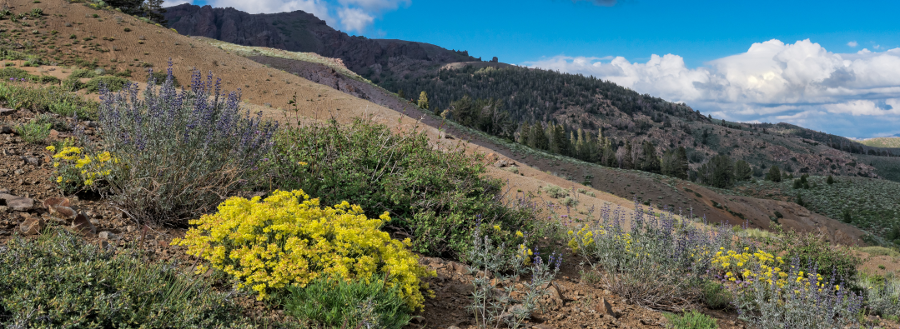PI: Peter B. Pearman
Collaborators: J. Travis Colombus (California Botanical Garden, Claremont, California), Jean-Rémi Trotta and Tyler S. Alioto (Centro Nacional de Análisis Genómico, CNAG, Barcelona)
Start date: April 1, 2014
Duration: ongoing
Research location: Western North America
Support: ad-hoc and discretionary
While mobile animals and plants with substantial dispersal capabilities have the ability to move to follow the changing distributions of suitable climate, many species will have to adapt in situ if they are to persist in the face of climate change. While it is difficult to predict future adaptation, substantial information on the evolutionary history of species in relation to climate can be found by examining genomic variation, current geographic distribution, and morphological variation. This information can be used to inform us about how species potentially respond to the ongoing changing climate. Species with spatial distributions that span substantial environmental variation provide an opportunity to examine how adaptation contributes to maintaining both species breadth and geographic range. In this project we examine geographic variability in genomic variation that has been shaped by both selective and neutral processes, representing both adaptation and demographic history. These genetic patterns reflect distinct processes that are involved in population-level responses to a changing environment. By understanding the history and genomic basis of these responses, we will contribute to understanding how large-scale environmental change may affect future population distribution and adaptation.
Adaptation and evolutionary history in non-model organisms (lacking a reference genome) is increasingly possible through the use of techniques to construct genomic libraries that subsample the genome. We have chosen this approach to develop research on the demographic and evolutionary history of Eriogonum umbellatum (Polygonaceae), a small shrub with bright yellow flowers in western North America. The range of this species extends from the Sierra Nevada almost to the Rocky Mountains, and from the mountains in the southern Mojave Desert to the eastern slopes of the Cascade Range in central Oregon. E. umbellatum is adapted to a variety of arid, semi-arid, and mountainous environments, and occurs on well-drained serpentine and non-serpentine soils. Taxonomists have recognized substantial, though subtle, morphological variation in this species and have described 40 varieties. These varieties vary in the extent of their distribution and the range of environmental conditions they encounter. The high level of taxonomic, morphological, and environmental variation exhibited by the species suggests that rapid adaptive evolution of environmental tolerance characterizes this widely distributed species. Characterizing the genomic basis of this variation, at loci influenced by selection and at others dominated by processes of genetic drift and dispersal, will deepen our understanding of the processes that promote species cohesion or, alternatively, isolate populations and lead to adaptive speciation.
This investigation of population structure, evolutionary history, and environmental adaptation in E. umbellatum builds on previous collaborative work on evolution in Eriogonum and Polygonaceae. In the current work, we have used Genotyping-by-Sequencing to develop a sequenced GBS library and dataset with thousands of bi-allelic SNPs. We have also developed additional genomic resources, including a substantial collection of tissues from over 60 populations, a draft genome using both long-read and Illumina technology, an annotated transcriptome, and a custom bioinformatics pipeline. We are currently examining the diversity within E. umbellatum and some closely related congeners and other relatives in an effort to determine the species boundaries and monophyly of this taxon. Our SNP data encompass about 30 additional species in the genera Eriogonum and Chorizanthe. Our initial analyses indicate that species-level designation is needed for some taxa that are currently distinguished at the varietal level.
Once we know species boundaries, we will examine intraspecific structure and identify potential loci under environmental selection. This will serve as the basis for modeling genome-environment associations and, subsequently, the geographic displacement of suitable environmental conditions as climate change progresses. To do this, we will develop ddRADseq libraries at UPV. After sequencing, additional modeling will address the demographic and phylogeographic history of the species through the Neogene. We intend to identify clusters of populations that share a common demographic and evolutionary history. With this information, we will examine the environmental distribution of potentially adaptive loci using targeted sequencing methods.
Relevant Publications
Kostikova, A., N. Salamin and P. B. Pearman. 2014. The role of climatic tolerances and seed traits in reduced extinction rates of temperate Polygonaceae. Evolution 68:1856-1870.
Kostikova, A., G. Litsios, S. Burgy, L. Milani, P. B. Pearman, and N. Salamin. 2014. Scale-dependent adaptive evolution and morphological convergence to climate niche in the Californian eriogonoids (Polygonaceae). Journal of Biogeography 41:1326-1337.
Kostikova, A., G. Litsios, N. Salamin, and P. B. Pearman. 2013. Linking life history traits, ecology and niche breadth evolution in the North American eriogonoids (Polygonaceae). American Naturalist 182:760-774.

